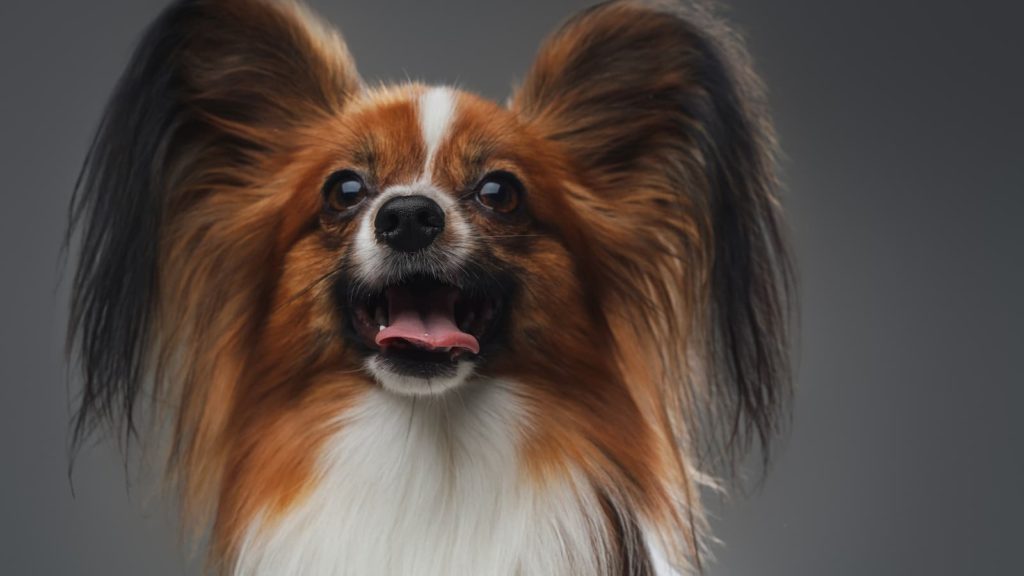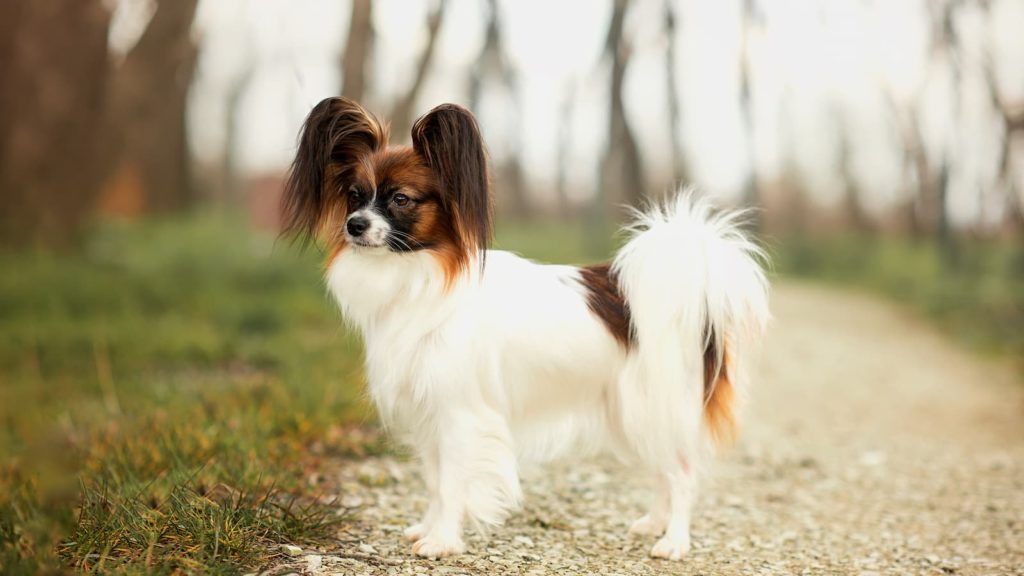If you have ever owned a Papillon, you already know what friendly, happy, and energetic dogs they can be! They are most oftentimes recognized because of their adorable ears that stand up straight!
Papillon ears are some of the most unique among dog breeds because they resemble a butterfly shape; However, this breed’s ears have slowly changed over time in many ways, including their shape and size.
In this article, we will talk about all things Papillon ears! Including ear cleaning methods, grooming, problems, and many others! If you are curious to learn more, keep reading!

Do All Papillons Have Butterfly Ears?
The Papillon breed (also called the Continental Toy Spaniel), is known for its unique butterfly-shaped ears that stand up straight; hence the breed’s name “Papillon,” which means “butterfly” in French!
While most all Papillons have butterfly-shaped ears, not all of them will have these largely distinct, stood-up ears. Some Papillons can have smaller, less fluffy ears which oftentimes appear floppy; these types of ears are called “phalene” or “night moth” ears!
Papillons in the past had smaller, floppier ears, but over time their ears changed and began to stand up straight. Some people believe that the reason their ears changed over time is because of a genetic mutation!
Most Papillon owners are proud of the beautiful long hair that grows from or around their Papillon’s ears. While a lot of these dogs will have this long hair, they don’t always have to.
This unique ear hair tends to grow slowly and not in large amounts, this is why most owners try not to trim the hair around the ears unless it becomes irritating for the dog.
Disclaimer: This post may contain affiliate links. We only recommend high-quality products that are used and recommended by real owners. If you use these links to buy something we earn a small commission.
When Do Papillon Ears Stand Up?
Many Papillon owners worry that if their dogs’ ears aren’t standing straight when they are born that they never will; however, this is usually not the case.
Papillons are normally born with floppy ears, their ears will begin to stand up on their own within the first few weeks of their lives.
It is important not to become worried if you notice your dogs’ ears not standing up within the first few weeks of their life, all Papillons are different, and their ears may just be taking longer to stand.
NOTE: It can sometimes take months for Papillon ears to stand up on their own, and sometimes they won’t stand at all. In rare cases, a Papillon may be born with straight ears, but they may begin drooping later on in life.

How to Make Papillon Ears Stand Up?
Papillon owners that are concerned that their dogs’ ears aren’t standing straight oftentimes wonder if there is any way to move the process along faster.
There are certain things that Papillon owners have been known to try to get their dog’s ears to stand up, normally by feeding them foods with a lot of calcium. This will help build up the cartilage in the ear, making the ear stand straighter!
Some foods that are common for Papillon owners to try and use to make their dog’s ears stand straighter include yogurt and cottage cheese, these are both very rich in calcium which helps the bone grow stronger!
There are other methods of making a dog’s ears stand up such as ear cropping (a surgical procedure where the ears are trimmed) or taping the ears up so they will grow straight.
Papillons are not a breed that usually has this done like a Boston Terrier or a Boxer would be. Even if Papillons continue to have floppy ears throughout their lives, they are still considered to be “breed standard.”
Why Does my Papillon Have Floppy Ears?
People who are not familiar with the Papillon breed often wonder why the breed will sometimes have floppy ears instead of the usual “butterfly” ears that are so popular.
Phalene or “moth” ears are common in the Papillon breed which causes their ears to appear floppier and hang down further; this usually occurs because of breeding!
There are other reasons why a Papillon may have floppier ears that are not caused by genetics including ear infections, or other ear issues.
Otitis is a common type of ear infection that Papillons have been known to develop. This is caused when the outer ear canal becomes extremely inflamed. Ear infections are usually caused because water or bacteria becomes trapped in the ear.
NOTE: If one of your Papillon’s ears has flopped over and the other has not, this usually indicates an ear infection or another type of health problem. It is best to visit your vet if you notice this happening to your dog!
There is also another simple reason why your Papillon’s ears are floppy, they may not have enough cartilage to hold the ears straight.
If a Papillon’s body is lacking calcium, floppy ears are likely to occur, that is why so many owners result to feeding their dogs’ calcium-rich foods!
Another great way to enhance your Papillon’s calcium intake is to start them on supplements like probiotics early. Probiotics can not only help a Papillon’s gut health, but they are very rich in calcium which can help their bone growth!
NOTE: Read this article to learn all about probiotics for puppies: Puppy Probiotics (Everything You Need to Know!)

Papillon Ear Problems
Because Papillon ears are so unique and well-known to the breed. Oftentimes owners wonder if there are any common ear issues associated with the breed that they should be aware of before bringing a Papillon into their family.
Papillons thankfully don’t have too many ear issues; however, they have been known to develop ear infections and deafness in one or both ears.
It is important to maintain a consistent ear cleaning routine to make sure that your Papillon isn’t at high risk of getting an ear infection.
Usually, long-lasting infections in the ear are the main cause of Papillons becoming deaf.
NOTE: Phalene Papillons are more at risk for ear infections than Papillons with butterfly ears. This is usually because floppy ears hold in more moisture and bacteria which are the main causes of ear infections.

How to Groom/Clean a Papillon’s Ears
Because Papillons are known for their amazing ears, a lot of owners want to make sure that those ears are taken great care of!
It is important to keep a Papillon’s ears consistently groomed and clean. There are several steps to take and products to use for this including maintaining the consistency of grooming/cleaning, using dog-safe ear cleaning solution, and blow-drying the ear fringe.
Brushing a Papillon’s ear hair consistently is one of the best grooming methods! It is important to do this at least every other day to ensure that the hair gets no tangles.
Because a Papillon’s ear hair doesn’t grow much and sometimes won’t grow back at all if cut too short, it is generally advised not to trim a Papillon’s ear hair.
TIP: If you notice your Papillon’s ear hair getting too long to the point that it is bothersome and overwhelming for your dog, it is okay to trim it!
As mentioned previously, Phalene Papillons are known to get ear infections more often than Papillons with butterfly ears since moisture and bacteria are easily trapped.
It is critical to keep the ears clean, especially for a Phalene Papillon, you can do this by using a cotton ball with a dog-safe ear cleaner! After pouring some of the cleaning solution onto the cotton ball, gently swab inside your dog’s ear.
It is not recommended to use a dog ear cleaning solution that contains alcohol in the ingredients list, this can be very irritating to the dog’s skin, especially for dogs with sensitive skin.
TIP: Keep cleaning until the cotton ball comes away without anything on it, this means that the ear is completely clean!
If you notice your Papillon keeps getting ear infections, you may consider plucking out any ear hair inside the ear with tweezers. Hair is usually what gathers the most bacteria and can cause irritation and infection.
NOTE: Talk with your vet before plucking out any inner ear hairs, they can show you the most effective and safe way to do this!
After bathing a Papillon, it is critical that their ears get dried off enough, especially if they have a lot of hanging ear hair.
Blow drying the ears is important because you don’t want to risk leaving behind any water that could find its way into the ear canal and can cause an infection.
When drying a Papillon’s ear hair, start at the back of the ear and brush from the bottom to the tip of the ear.
By brushing this way, you will notice that your Papillon’s ear hair looks very nice, and your dog will be more comfortable during the grooming process.
How Long Does It Take for Papillon Ear Hair to Grow?
Papillon owners who love the long-haired ear look on the breed oftentimes wonder how long it will take for their dog, in particular, to grow out that unique and popular-looking ear hair.
It usually takes longer than 1 and a half years for a Papillons ear fringe to fully grow out; However, once it is grown, it usually will not grow back the same if cut/trimmed or it may not grow back at all.
The texture and amount of a Papillons ear hair usually determines whether or not they will grow back any ear hair that is trimmed.
NOTE: Even if the hair does grow back, it probably won’t be the same texture/look as it was before, just like what happens to some breeds when they are shaved.
There are several types of ear hair textures that a Papillon can have depending on the genetics of their parent breed. These include fine/silky and thick/coarse.
Papillons can come in a variety of different fur colors which make their ear hair appear unique as well.
Some of the fur colors that Papillons often have include:
- Red
- Sable (darker with shades of black and brown)
- White
- Brown
- A mix of red and white
- Brown and white
- White, black, and tan
- Red, white, and sable
- Tan and white
- Etc.
Depending on what type of fur color a Papillon has can determine how much ear hair they have.
Red and sable Papillons tend to grow less ear fringe than other colors of Papillons because their hair is very fine and can break easier.
Papillon’s that have white, tan, and darker color fur tend to grow more ear fringe because the hair breaks less and grows faster.
Here are some tips to make your Papillon’s ear hair grow out faster:
- Consistently brush and groom your Papillon’s ear fringe.
- Give your Papillon a weekly bath, this keeps the hair in better condition.
- Avoid having your Papillon in situations where their ear hair could be damaged, such as swimming, playing with other dogs that pull on their hair, or other activities that may result in damaging the fragile ear hair.

Types of Papillon Ear Fringes
Just like a lot of other dog breeds that have unique grooming styles, Papillons are known for having a variety of different ear fringes.
The different appearances of Papillon ear fringes depend on the texture and amount of hair that the dog has.
Here are a few examples of the type of ear fringes that Papillons will have:
- Ear hair appears shorter at the tip of the ear but there is longer, finer, and silkier hair that is hanging off the bottom and sides of the ear.
- Ear hair appears long and almost curly/wavy, this type of fringe is usually coarser in texture (a lot of darker colored Papillons will have this) – will appear “fluffier”
- “Curtain Fringe” – Sometimes a butterfly-eared Papillon who has this type of fringe is mistaken as a Phalene Papillon. The way that the ear fringe lays make it look as if the ear is hanging, while really, it is just the ear hair!
What do Papillon Ear Positions Mean?
Like a lot of other dog breeds, Papillons are sometimes easy to read simply based on their ear positions.
Papillon ear positions can indicate many different feelings and emotions going on with your dog such as frustration, anger, excitement, fear, anxiety, happiness, etc.
Because Papillons have such unique and distinct ears, it is oftentimes easy to get a good read on their emotions simply because of their ear positions.
Here are a few ear positions that Papillons may have that indicate certain emotions:
- Stood straight and relaxed — Calm and friendly.
- Straight and turned slightly inward — Alert, on edge, or interested in something. (You may notice this if your dog is stressed or in a new environment/social setting.)
- Slightly back — Excited
- Fully back — Fearful or anxious
- Moving at odd angles/back and forth — Usually when a Papillon moves their ears in different directions this just means that they hear something and are trying to listen more closely.
NOTE: Although Papillons with butterfly ears will already have ears that are standing straight, if you notice a stiffness to the ears that appears as if they are forcing their ears straighter, this may indicate they are in pain, very alert, or sick.



